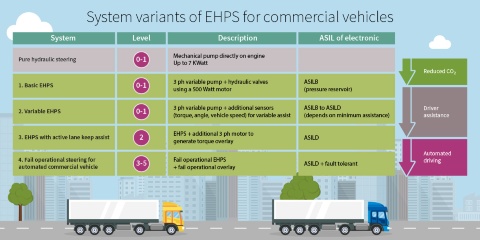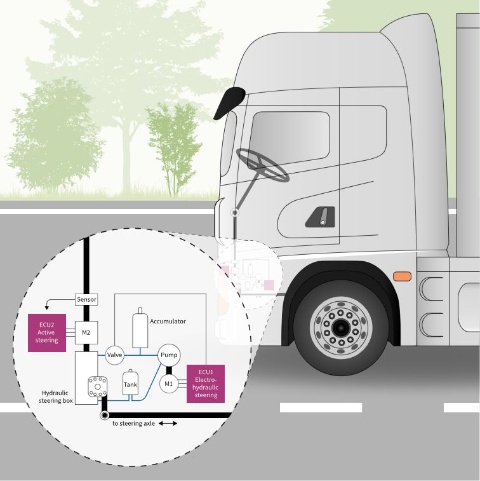System variants of EHPS for commercial vehicles

(1-2) EHPS - Pure electro hydraulic steering benefits (basic and variable EHPS):
- Fuel savings of 0,9 to 1,2%
- CO2 reduction of 6 to 11g /km
The safety requirements that apply to basic EHPS are not as strict as those that apply to more complex steering systems. As adoption of level 2 automation increases, EHPS and full EPS are become standard in tomorrow’s vehicles.
(3) EHPS with active lane keep assist benefits:
- Using EHPS for base functionality
- Adding 1x 3ph motor to generate torque overlay
- Motivation: reduced accident and insurance costs
(4) EHPS - Fail operational steering benefits:
- Full fault tolerant steering
- Different variants in design
- Variants using hydraulic power
- Variants using electric-only power steering
- Synergies with fault-tolerant EPS for cars
- Motivation: highly automated trucks at level3 and level4
From Driver Assistance to Automated Driving:

Accidents are always unnecessary and tragic, but the impact of commercial vehicle accidents is usually significantly more serious. Accidents can be prevented by lane assistance systems. Driving safety systems and driving aids have been implemented, tried and tested in passenger cars for several years already, and they are increasingly being used in commercial vehicles likes trucks, busses, forklifts or agricultural vehicles, too.
Infineon offers a broad range of semiconductor solutions supporting 24 V EHPS to enable features such as lane keep assist, which helps to increase convenience for the driver and the overall safety of the trucking business. The 24 V EHPS for fail-operational steering enables autonomous driving for CAVs.


